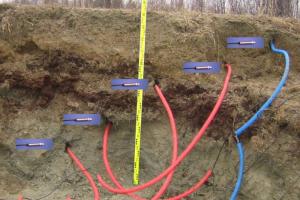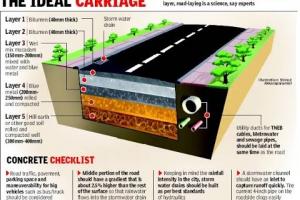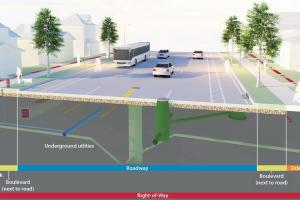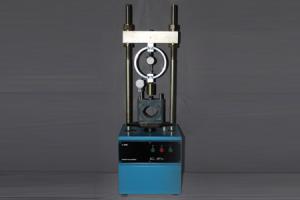Simple Asphaltic Concrete Roads | Design & Properties

Hot mix asphalt cement is a material which has revolutionized road construction process.Hot mix asphalt paving consists of a combination of aggregates uniformly mixed and coated with asphalt cement. The term Hot Mix is used due to the fact that to dry the aggregates and to attain the desired degree of fluidity of the asphalt cement for proper mixing and workability. Both the asphalt and the aggregates must be heated before mixing. This is done in an asphalt mixing plant.
Design of Mix for Concrete Road
Design of mix refers to statements by which various aggregates and asphalt cement is to be mixed to yield a mix possessing desired qualities and characteristics These qualities are as follows:
- Sufficient asphalt to ensure durability of the pavement.
- Sufficient stability to satisfy the demands of the traffic without distortion.
- Sufficient voids in the total compacted mix to allow for a slight amount additional compaction under traffic loading , without flushing , bleeding and loss of stability, yet low enough to keep out harmful moisture content.
- Sufficient workability to permit efficient placement of the mix.
Materials
 Aggregates are hard rigid material which constitutes the bulk portion of the mix used for the construction of the pavement.In majority of the cases the aggregate is natural rock, either in crushed form or uncrushed. It may be lime stone, basalt or granite. The crushing is restored to, to obtain the suitable sizes for optimum design mix.
Aggregates are hard rigid material which constitutes the bulk portion of the mix used for the construction of the pavement.In majority of the cases the aggregate is natural rock, either in crushed form or uncrushed. It may be lime stone, basalt or granite. The crushing is restored to, to obtain the suitable sizes for optimum design mix.
Gradation of Aggregate
The grading of aggregate denotes the distribution of sizes. The grading is determined by running the material through a number if sieves with progressively smaller openings and weighing the material retained on each sieve.
Desired Characteristics of Aggregates for Roads
Strength & Toughness
The aggregate in a bituminous mixture supplies most of the mechanical stability. It must support the loads imposed by the traffic and at the same time distribute these loads to the sub bases at a reduced intensity. The aggregate used in the mix tend to break or degrade by the traffic loads. The amount of degradation is effected by both the magnitude of the applied loads and the resistance to the crushing or abrasion of aggregate.
Soundness
Stones which disintegrate badly under the action of the weather are termed as unsound. Shale is a typical example because water enters into it and freezes, causing it to expand and disintegrate. Unsound stones are obviously unsatisfactory as asphalt pavement .
Cleanliness
The cleanliness of an aggregate may often be determined by visual observation but a washed sieve analysis will produce a positive proof. The objectionable materials are shale, soft particles, clay lumps etc. Aggregates must be clean to bind properly with fine particles to form a dense mix. The presence of impurities tends to weaken the bond between aggregate and the binding material.
Internal Friction
This is a property in aggregates which resist the movements of the stones pass one another under the action of an imposed load. This resistance is formed by inter locking of the stones and the surface friction between adjacent particles. A particle having rough jagged surface has a high degree of internal friction in contrast to a rounded particle which forms a relatively less stable interlock with its neighboring particles.
Low Porosity
A certain degree of porosity is desirable in an aggregate since it permits the bituminous material to penetrate into the aggregate. However high porosity is disadvantageous because of the extra cost incurred on the bitumen for filling the voids.
Surface Properties
The surface properties of an aggregate vary considerably in their affinity for asphalt. Asphalt which have a high affinity for asphalt are called hydrophilic e. g. basalt, limestone & dolomite and the aggregates which are difficult to coat with the asphalt are called "hydrophilic" e. g. quartzite.
Sources of Aggregates
- Igneous Rocks
- Sedimentary Rocks
- Metamorphic Rocks
- Industrially prepared Aggregates
Main Groups of Road Aggregates
Natural Aggregates
Majority of road aggregates are formed from natural rocks. The term rock is used here refers to a compact hard mass of material composed of minerals which are held together by various means.
Artificial Aggregates
The principal artificially formed aggregate which is used in road construction is air cooled "Blast Furnace Slag". This material is very limited in its used for road building purposes at this time. When produced under controlled conditions, slag makes an excellent road aggregate. It is uniform in density and quality and contains few glassy fragments.
Asphalts
Asphalt is the world's most versatile construction material today. It belongs to a vast class materials falling under the heading bituminous materials.
Binder
A material used for purpose of holding the solid particles together.
Bitumen
A viscous liquid or solid or semi liquid consisting essentially of hydrocarbons and their derivatives which is soluble in carbon disulphide, is substantially non volatile and softens gradually when heated. It is black or brown in color and possesses adhesive and water proofing qualities.
Asphalt
A general term for certain mixtures of asphalt cement and mineral matter.
Tar
A viscous liquid black in color with adhesive properties obtained by destructive distillation of coal, wood etc.












